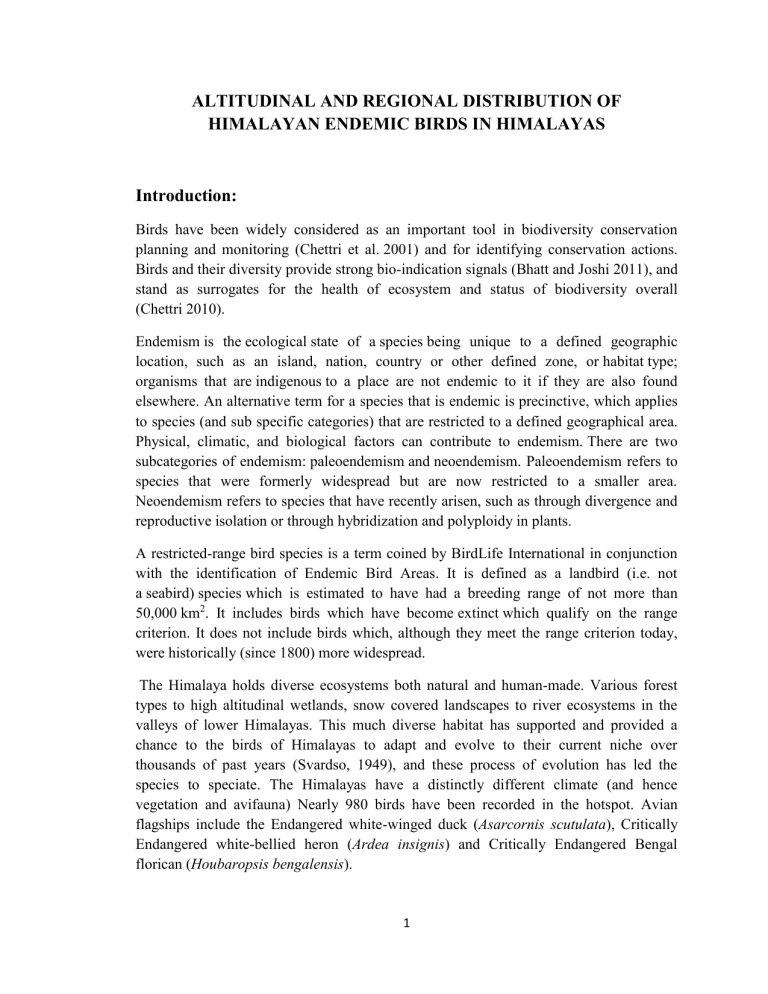
ALTITUDINAL AND REGIONAL DISTRIBUTION OF HIMALAYAN ENDEMIC BIRDS IN HIMALAYAS Introduction: Birds have been widely considered as an important tool in biodiversity conservation planning and monitoring (Chettri et al. 2001) and for identifying conservation actions. Birds and their diversity provide strong bio-indication signals (Bhatt and Joshi 2011), and stand as surrogates for the health of ecosystem and status of biodiversity overall (Chettri 2010). Endemism is the ecological state of a species being unique to a defined geographic location, such as an island, nation, country or other defined zone, or habitat type; organisms that are indigenous to a place are not endemic to it if they are also found elsewhere. An alternative term for a species that is endemic is precinctive, which applies to species (and sub specific categories) that are restricted to a defined geographical area. Physical, climatic, and biological factors can contribute to endemism. There are two subcategories of endemism: paleoendemism and neoendemism. Paleoendemism refers to species that were formerly widespread but are now restricted to a smaller area. Neoendemism refers to species that have recently arisen, such as through divergence and reproductive isolation or through hybridization and polyploidy in plants. A restricted-range bird species is a term coined by BirdLife International in conjunction with the identification of Endemic Bird Areas. It is defined as a landbird (i.e. not a seabird) species which is estimated to have had a breeding range of not more than 50,000 km2. It includes birds which have become extinct which qualify on the range criterion. It does not include birds which, although they meet the range criterion today, were historically (since 1800) more widespread. The Himalaya holds diverse ecosystems both natural and human-made. Various forest types to high altitudinal wetlands, snow covered landscapes to river ecosystems in the valleys of lower Himalayas. This much diverse habitat has supported and provided a chance to the birds of Himalayas to adapt and evolve to their current niche over thousands of past years (Svardso, 1949), and these process of evolution has led the species to speciate. The Himalayas have a distinctly different climate (and hence vegetation and avifauna) Nearly 980 birds have been recorded in the hotspot. Avian flagships include the Endangered white-winged duck (Asarcornis scutulata), Critically Endangered white-bellied heron (Ardea insignis) and Critically Endangered Bengal florican (Houbaropsis bengalensis). 1 The Himalayan species includes approximately 450 breeding species, and 43 species are endemic to the Himalayas (Bird Life International, 2019) including 11 endemic species in western Himalaya, 19 endemic and 22 range restricted species in eastern Himalaya (Stattersfield et al. 1998; Jathar and Rahmani 2006). The eastern Himalayas have a distinctly different climate (and hence vegetation and avifauna) to the rest of the range, as they lie further to the south and have warmer mean temperatures and fewer days with frost, and generally have a much higher rainfall. They extend from the Arun-Koshi valley in eastern Nepal, through Bhutan, north-east India, south-east Tibet and northern Myanmar to north-west Yunnan in China, and are here taken to include the mountains which extend from Nagaland and Manipur in India south to the Chin Hills in Myanmar and the Chittagong Hills in Bangladesh. The Eastern Himalayan Mountain range is identified as an endemic bird area (Birdlife International 2001), which supports 22 restricted-range bird species of which 19 are endemic to the Eastern Himalayas (Stattersfield et al. 1998; IUCN 2009). The Western Himalayas EBA extends along the mountain chain from western Nepal (west of the Kali Gandaki valley) through Uttar Pradesh, Himachal Pradesh, Jammu and Kashmir in north-west India and northern Pakistan, and then south-west along the mountains in the border region between Pakistan and Afghanistan. The restricted-range birds breed in west Himalayan temperate forest, including coniferous, broadleaf and mixed broadleaf–coniferous, and some of them range into adjacent montane grassland and subalpine forest. 1.2 Objective To know about altitudinal and regional distribution of Birds of Himalayas 2. Materials and Methods Secondary data was taken from herbarium specimens, books, articles and websites. 2 3. Result and Discussion: 3.1 Avian composition A total of 43 species of birds belonging to 17 families are endemic in Himalayas out of which most endemic species belong to family Leiothrichidae as shown in the pie chart below : Families of endemic birds 1 1 2 1 4 1 2 1 2 4 1 1 8 2 2 7 3 Fig 1: Pie chart of endemic birds belonging to different Families 3.2 Distribution of endemic birds along altitudinal gradient 3 Aegithalidae Apodidae Certhiidae Corvidae Fringillidae Leiothrichidae Muscicapidae Paridae Phasianidae Phylloscopidae Pnoepygidae Scotocercidae Sittidae Sylviidae Timaliidae Trogonidae Zosteropidae The highest no of endemism is in the altitudinal range of 2000-3000 m i.e. 39 species are found in this range and the least no of endemic birds species are found in 4000-5000m i.e. only 4 species of endemic birds are found above 4000m. No of species in different altitudinal gradient 45 39 40 33 35 30 23 25 20 15 11 No of species 10 4 5 0 Fig 2: Bar graph of distribution of endemic birds along altitudinal gradient 3.3. Distribution of endemic birds in the different regions of the Himalayas Along the Himalaya the highest endemism in birds was found in the eastern Himalayas which is 23 and least in central Himalayas which is 5 and 2 species are only found in the whole Himalaya. 4 DIstribution of Himalayan endemic birds 25 23 20 15 13 No. of Species 10 5 5 2 0 CH EH WH Whole himalaya Fig3: Bar graph of the distribution of Himalayan endemic birds in different regions 3.4 Distribution of endemic birds in different countries of the Himalayas Highest no of species are found in India which is 41 followed by Nepal that is 28 and least no of endemic species are found in Bangladesh that is 2 species. No. of birdsspecies in different countries of Himalayas 45 40 35 30 25 20 15 10 5 0 41 28 13 21 17 18 17 no of bird species 2 Fig 4 Bargraph of no. of Himalayan endemic birds in different countries of the himalayas 5 4. Conclusion: The Himalaya holds diverse ecosystems where 980 species of birds have been recorded in the hotspot out of which 43 are endemic to the Himalayas. The results showed that among the birds of 450 breeding species, and 43 species are endemic to the Himalayas, 23 are endemic to the Eastern Himalayas, 13 endemic species in Western Himalaya, 5 species are endemic to Central Himalayas and 2 species are found in the whole Himalayas which are spot-winged tit and Himalayan monal. The most of the endemic birds belong to family Leiothrichidae that is 8 species. The highest no of endemism is in the altitudinal range of 2000-3000 m i.e. 39 species are found in this range and the least no of endemic birds species are found in 4000-5000m i.e. only 4 species of endemic birds are found above 4000m. The result shows that it is humped shaped pattern which means that the no of endemic species is increasing in the beginning and when reached the altitude of 2000-3000 it were maximum and the stars to decline. The highest no endemic birds of the Himalayas are found in India after that Nepal and least is found in Bangladesh. 6 Refrences: Bhatt D, Joshi K.K. (2011) Bird assemblages in natural and urbanized habitats along elevational gradient in Nainital district (Western Himalaya) of Uttarakhand state, India. Curr Zool.;57:318–29. BirdLife International (2019) Endemic Bird Areas factsheet: Western Himalayas. Downloaded from http://www.birdlife.org on 04/11/2019. BirdLifeInternational (2001). Threatened birds of Asia: the BirdLife International Red data book. BirdLife International,Cambridge, U.K., 3,038pp. Chandra, K., Gupta, D., Gopi, K.C., Tripathy, B. and Kumar, V.,( 2018). Faunal Diversity of Indian Himalaya: 1-872. Chap 51 ISBN 978-81-8171-478-7 Chantler, P. & Kirwan, G.M. (2019). Dark-rumped Swift (Apus acuticauda). In: del Hoyo, J., Elliott, A., Sargatal, J., Christie, D.A. & de Juana, E. (eds.). Handbook of the Birds of the World Alive. Lynx Editions, Barcelona. (retrieved from https://www.hbw.com/node/55336 on 6 November 2019). Chettri N., Sharma E., Deb D.C. (2001)Bird community structure along a trekking corridor of Sikkim Himalaya: a conservation perspective. Biol Conserv;102:1–16. Chettri N,.(2010)Cross-taxon congruence in a trekking corridor of Sikkim Himalaya: surrogate analysis for conservation planning. J Nat Conserv18:75–88. Clements, F. A. (1992). Recent bird records from Bhutan. Forktail, 7: 57-74. 7 Inskipp, C.and Inskipp, T.P. (1991). Birds of Nepal. Second edition. London: Christopher Helm. IUCN (2009). IUCN Red List of Threatened Species. <http://www.iucnredlist.org.>. Online version 2009.1 dated 14 June 2009. Jathar, G.A. & A.R. Rahmani (2006). Endemic birds of India. Buceros11: 5-53. Stattersfield, A.J., Crosby M.J., Long A.J. & Wege D.C. (1998). Endemic Bird Areas of the World: Priorities for Biodiversity Conservation. BirdLifeConservation Series No. 7. BirdLife International, Cambridge, U.K. webpages https://www.orientalbirdclub.org/eastern-himalayas accessed on 2019/11/10 http://datazone.birdlife.org/eba/factsheet/124 Annex Table1: List of Himalayan endemic birds SN 1 2 3 4 5 6 7 8 9 10 11 12 Name of the species Ophrysia superciliosa Tragopan melanocephalus Catreus wallichi Aegithalos leucogenys Aegithalos niveogularis Phylloscopus subviridis Sitta cashmirensis Ficedula subrubra Callacanthis burtoni Pyrrhula aurantiaca Pnoepyga immaculata English name Family Himalayan quail Western tragopan Cheer pheasant Whitecheeked tit Whitethroated tit Brooks's leafwarbler Kashmir nuthatch Kashmir flycatcher Spectacled finch Orange bullfinch Nepal cupwing Phasianidae Distribu tion WH Phasianidae WH Phasianidae WH Aegithalidae WH Aegithalidae WH Phylloscopidae WH Sittidae WH Muscicapidae WH Fringillidae WH Fringillidae WH Pnoepygidae CH Turdoides nipalensis Spiny babbler Leiothrichidae CH 8 Altitude Country 1,650 to 2,400 m. 1,750 to 3,600 m 1500 to 2500m 1500 to 3660m 1800 - 3965 m 2100 - 2700 m 1,800 -3,350 m 1800 - 2700 m 2270 - 3330 m 2700 - 3900 m 1730 - 3100 m India, Nepal 915-2135m Nepal India, Pakistan Pakistan, India, and Nepal. India, Pakistan, Afghanistan India; Nepal; Pakistan India, Pakistan, Afghanistan Afghanistan; India; Nepal; Pakistan Bhutan; India; Nepal; Pakistan Afghanistan; India; Nepal; Pakistan India; Pakistan India ; Nepal 13 Actinodura nipalensis 14 Arborophila mandellii 15 Tragopan blythii Lophophorus sclateri Apus acuticauda Harpactes 1 wardi Phylloscopus cantator Tickellia hodgsoni 16 17 18 19 20 21 Spelaeornis caudatus 22 Spelaeornis badeigularis Spelaeornis longicaudatus 23 24 Stachyris oglei 25 27 Trochalopteron virgatum Trochalopteron austeni Sibia nipalensis 28 Sibia waldeni 29 Yuhina bakeri 30 Fulvetta ludlowi Heterophasia gracilis Heterophasia pulchella Sitta victoriae 26 31 32 33 Hoarythroated barwing Chestnutbreasted partridge Blyth's tragopan Sclater's monal Dark-rumped swift Ward' s trogon Yellow-vented warbler Broad-billed warbler Leiothrichidae CH 1400-3500m Phasianidae EH 350 - 2500 India; Bhutan; China m Phasianidae EH Phasianidae EH Apodidae EH Trogonidae EH Phylloscopidae EH Scotocercidae EH 1800 - 3300 m 3000 - 4200 m 200 - 2470 m 1,500– 3,200 m 300 - 2000 m 1050 - 2850 m Rufousthroated wrenbabbler Rusty-throated wren-babbler Tawnybreasted wrenbabbler Snowythroated babbler Striped laughingthrush Brown-capped laughingthrush Hoarythroated barwing Streakthroated barwing White-naped yuhina Ludlow's fulvetta Grey sibia Timaliidae EH 1500 - 2500 Bhutan; India; Nepal m Timaliidae EH Timaliidae EH 1800 - 2400 India m 1000 - 2000 India m Timaliidae EH 450- 1800m India; Myanmar Leiothrichidae EH 900-2400m India; Myanmar Leiothrichidae EH 1800-3000m India; Myanmar Leiothrichidae EH 1400-3500m Bhutan; China; India; Nepal Leiothrichidae EH 1700-3300m China; India; Myanmar Zosteropidae EH Sylviidae EH Leiotrichidae EH Beautiful sibia Leiotrichidae EH White-browed nuthatch Sittidae EH 300 - 2200 Bangladesh; Bhutan; China; m India; Myanmar; Nepal 2450-4000m Bhutan; China; India; Myanmar; Nepal 900 - 2800 China; India; Myanmar m 1650 - 3200 China; India; Myanmar m 2300 - 3000 Myanmar m 9 Bhutan, China, India, Nepal Bhutan; China; India; Myanmar China; India; Myanmar Bhutan, India, Nepal Bhutan; China; India; Myanmar; Bangladesh Bhutan; China; India; Myanmar; Nepal; Bhutan; China; India; Myanmar; Nepal 34 Brachypteryx hyperythra Rusty-bellied shortwing Muscicapidae EH 150 - 3000 China; India; Myanmar m 35 Lophophorus impejanus Himalayan monal Phasianidae Himalay as 36 Garrulus lanceolatus Nucifraga multipunctata Sitta leucopsis Black-headed jay Larger-spotted nutcracker Whitecheeked nuthatch Certhia Rusty-flanked nipalensis treecreeper Periparus melanol Spot-winged ophus tit Corvidae WH Corvidae WH Sittidae WH 2100 - 4500 Afghanistan, Pakistan, Nepal, m India, Bhutan, China and Myanmar 1500 - 3000 Afghanistan; India; Nepal; m Pakistan 850-3000m Afghanistan; China; India; Nepal; Pakistan 2100 - 3660 Afghanistan; India; Nepal; m Pakistan Certhiidae EH Paridae Himalay as Machlolophus xanthogenys Sitta himalayensis Sylviparus modestus Black-lored tit Paridae WH White-tailed nuthatch Yellowbrowed tit Sittidae EH Paridae EH 37 38 39 40 41 42 43 10 2000 - 3660 Bhutan; China; India; m Myanmar; Nepal 1200-4570m Afghanistan; Bhutan; China; India; Myanmar; Nepal 600 - 2400 China; India; Nepal; Pakistan m 1000-3000m Bhutan; China; India; Myanmar; Nepal; 1450-2600m Bhutan; China; India; Myanmar; Nepal; Thailand; 11




